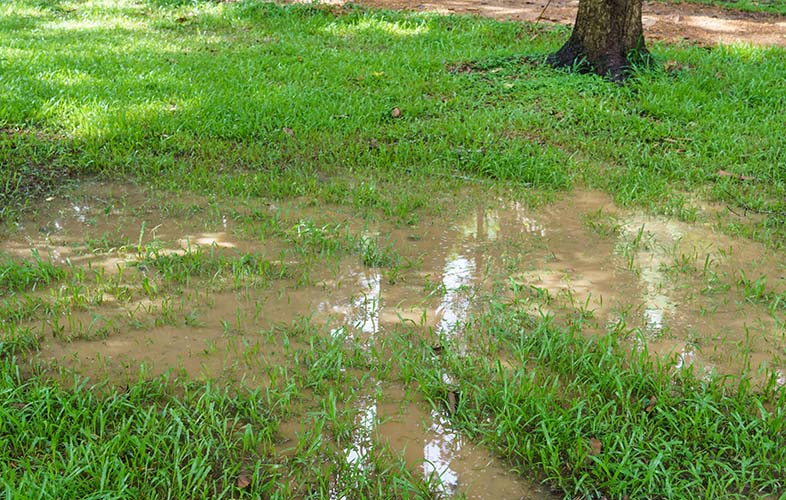From snow mold to desiccation, here are some of the most common types of winter lawn damage to look out for.
Ice Damage
A small coating of frost may cause wilting or discoloration, but a thick layer of ice can outright kill your grass. When ice covers your lawn, it prevents your grass from accessing the oxygen it needs to survive, essentially smothering it. And if temperatures get cold enough for the soil to freeze, grass can’t get the water it requires for basic survival. This can lead to winter kill.
The time it takes for an ice layer to kill grass can range from a couple of weeks to a couple of months — it depends on the grass type and thickness of the ice. Younger plants and new growth are more susceptible to winter kill, as their foundations are not as strong against the cold. For warm-season grasses that have a low tolerance to cold temperatures, eliminating nitrogen from your fertilizer about 6 to 8 weeks before the first frost will reduce new growth and help prevent damage.
- How to Recover: Aeration in spring can help revive the lawn.
Desiccation
Winter desiccation is a bit like windburn. It occurs when cold, dry winds remove moisture from plants faster than they can regain it. The lack of moisture can dehydrate the base of a grass plant — where new growth emerges — and may lead to eventual winter kill. To help prevent or reduce desiccation damage, make sure your grass stays hydrated by maintaining a regular watering schedule throughout the fall.
- How to Recover: Water the lawn thoroughly in spring and consider applying a light layer of organic material or compost to warm season lawns to retain moisture.
Snow Mold
Snow mold is a fungal lawn disease that occurs when snow cover remains on the ground for extended periods of time in late winter. The trapped moisture combined with the weight of the snow creates ideal conditions for snow mold to develop. It typically becomes noticeable in springtime as the snow and ice begin to thaw. This damage often can be seen as large patches of matted, yellow-green areas that can turn white or pink. Mowing your grass short for the last mow of the year will prevent long blades from becoming matted down in late winter and can help to prevent snow mold growth. You can also manually remove thick piles of snow to help defend against snow mold on grass.
- How to Recover: Rake the affected areas to allow more sunlight to reach the soil and promote faster green up.
Crown Hydration
Crown hydration primarily occurs in the late winter, after repeated cycles of thawing and freezing. In thawing periods, the frost melts when the temperature gets slightly warmer, and plants assume it is spring and absorb the water. However, when there is a rapid drop in temperatures, the absorbed water re-freezes, which can rupture cell membranes and damage (or even kill) the grass. Crown hydration appears as large patches of discolored turf and is common in poorly drained areas, such as golf courses.
- How to Recover: Improve drainage and aerate the soil to enhance water absorption and prevent re-freezing.


 Branch Finder
Branch Finder















 Back to all blogs
Back to all blogs

Facebook
X
Youtube
Copy Link
Email